Mexico City’s reopening varied widely Wednesday, with some people wearing face masks and keeping their distance while others jostled in crowded streets.
The limited reopening of restaurants and other businesses in the capital came as cases continued to climb steadily. On Wednesday, the number of cases nationwide rose by 5,681 to reach 231,770, and the country added 741 confirmed COVID-19 deaths, bringing the total to 28,510. Mexico City has accounted for about 48,000 cases and 5,400 deaths.
As shops opened, Mexico City resident Zeny García and her three children went shopping for shoes, equipped with face masks and goggles. But others around her wore their face masks around their necks.
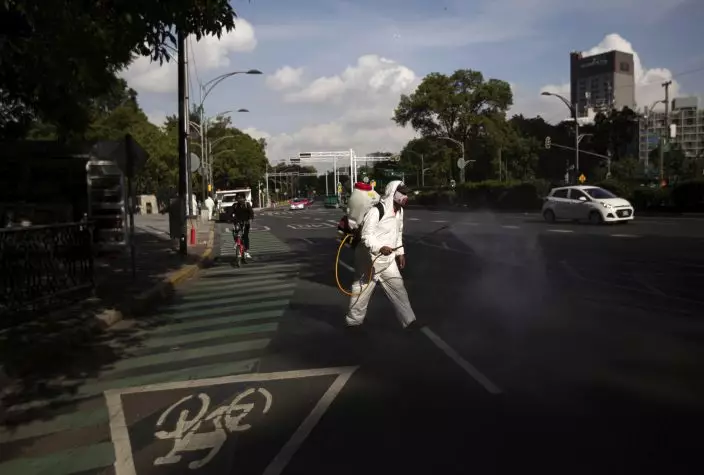
A city worker, dressed in protective gear, sprays disinfectant as a measure to curb the spread of the new coronavirus, on the perimeters of Chapultepec Park which has reopened after being closed for several months, in Mexico City, Wednesday, July 1, 2020. On a four-color alert level, in which red is the worst and green the best, Mexico City downgraded the city’s alert to “orange” even though it has the country’s largest numbers of infections and deaths. (AP PhotoFernando Llano)
“We just had to get out,” García said of the three-month lockdown that just began to ease this week. Restaurants and hotels are still not allowed to serve their full capacity, and bars, nightclubs and sporting events remained closed.
On the sidewalks of the city's colonial downtown district, taco stands were open and doing a brisk businesses, as promoters handed out fliers to passersby.
The district is the heart of Mexico's personal electronics, telephone and computing trade, and while most of those businesses were shuttered, touts stood on the sidewalk to drum up black market business for the same items.
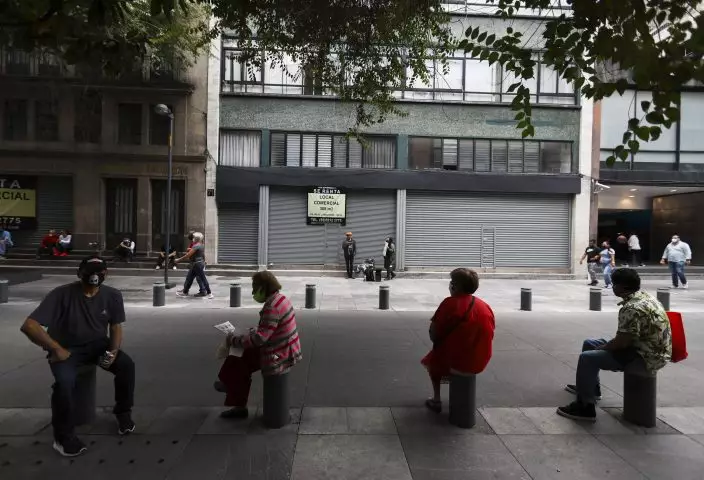
People keep their distance from each other to help curb the spread of the new coronavirus, at a street in Mexico, City, Wednesday, July 1, 2020. (AP PhotoEduardo Verdugo)
Restaurants are now allowed to serve customers at about 40% capacity, but most appeared to be well under that limit.
Rosa Icela Vázquez was one of those who ventured out to eat at one of Mexico City's most historic restaurants, the centuries-old Casa de los Azulejos, whose exterior is covered in blue-and-white ceramic tiles.
“It's not as if we should be going out yet, but we were getting fed up with being inside,” said Vázquez, who was sitting at a table with her husband and her granddaughter.
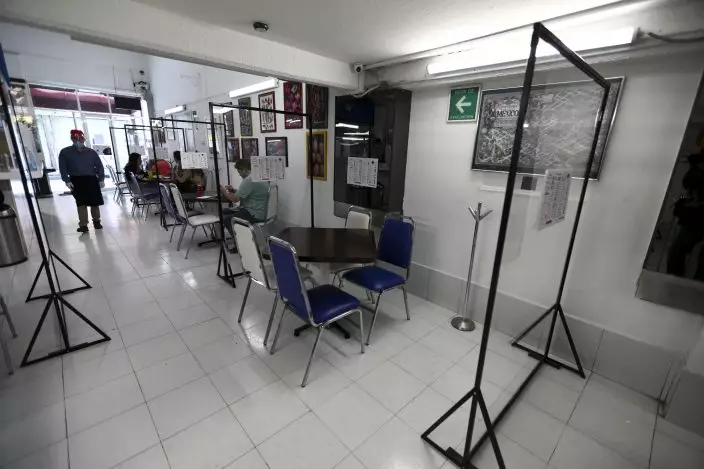
Separated by transparent dividers, customers eat in a restaurant while keeping their distance to help curb the spread of the new coronavirus, in Mexico City, Wednesday, July 1, 2020. (AP PhotoEduardo Verdugo)
The restaurant closed for the first time in memory during the lockdown. It had remained open even during the 1910-1917 Revolution, when revolutionary leaders like Pancho Villa and Emiliano Zapata ate there.
“COVID accomplished what the Revolution couldn't,” noted the restaurant's manager, Virginia Viedma.
While the restaurant's employers wore masks and face protectors and there was hand gel and shoe-sanitizing carpets, it had received only about three dozen customers by the afternoon — a far cry from its daily average of 1,800 diners on a normal day. “People are starting to come out,” Viedma said.
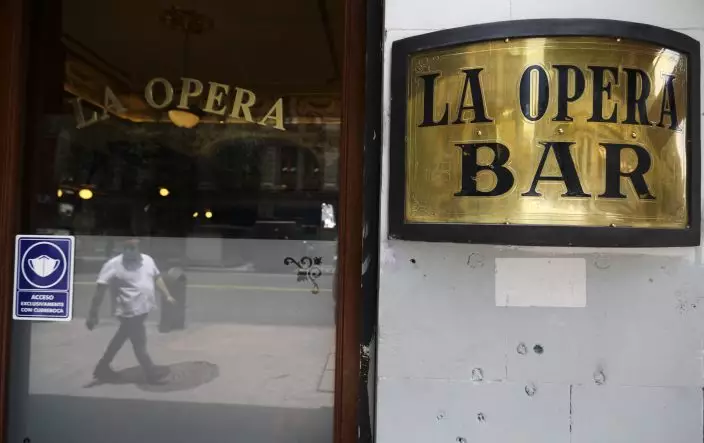
COVID-19 prevention signs are displayed on the windows of a restaurant in Mexico City, Wednesday, July 1, 2020. (AP PhotoEduardo Verdugo)
Police closed off some downtown streets and there were no crowds in the central square, but some of the streets leading on to it were packed.
City authorities have tried to manage the partial, gradual reopening by allowing businesses on one side of the streets to open one day, and those on the other side the next.
But that meant “people crowd into one side of the street one day, and the other side the next,” said policeman Edgar López.
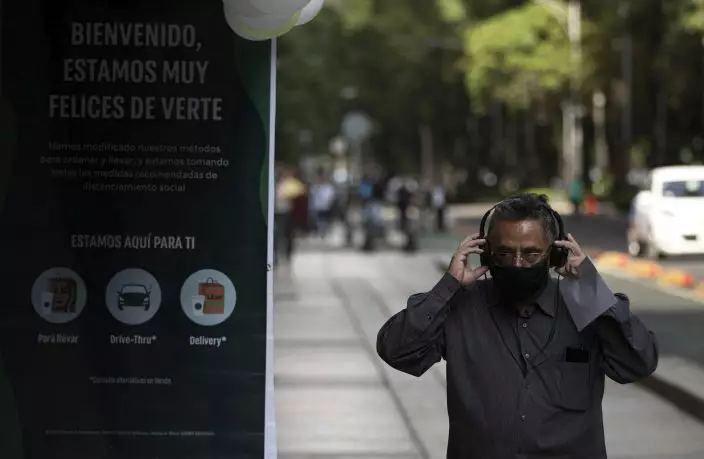
A customer, wearing a protective face mask as a measure to help curb the spread of the new coronavirus, adjusts his headphones prior to entering a coffee shop with an outdoor display panel that reads in Spanish: "Welcome, we are very happy to see you" in Mexico City, Wednesday, July 1, 2020. On a four-color alert level, in which red is the worst and green the best, Mexico City downgraded the city’s alert to “orange” even though it has the country’s largest numbers of infections and deaths. (AP PhotoFernando Llano)
Travel company representatives like Luis Oviedo tried to drum up business for tours of the city near the city's cathedral, and while foreign tourists were rare, Oviedo noted that “people are starting to come out, Mexicans who are stressed and want to get out.”
Horacio Cerón, a faith healer who performs ritual “cleanings” against bad luck, said he was doing about 20 ceremonies per day.
“People are coming to us because there are a lot more problems, with fewer jobs and less money,” Cerón said.
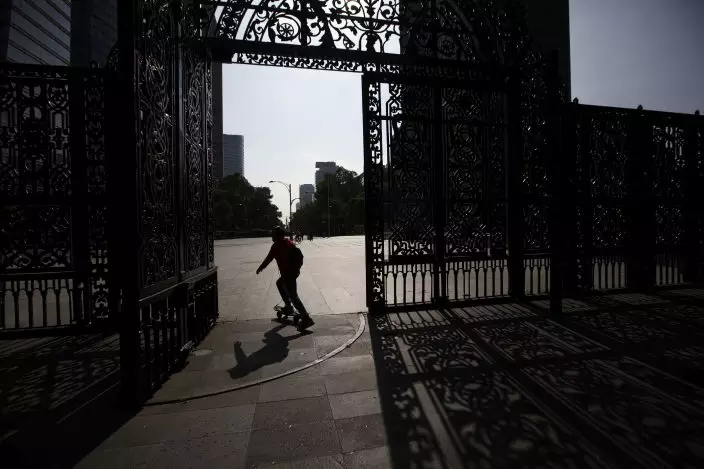
A skater rides through what is known as the lions gate entrance to Chapultepec Park which has reopened after being closed for several months to help curb the spread of the new coronavirus, in Mexico City, Wednesday, July 1, 2020. On a four-color alert level, in which red is the worst and green the best, Mexico City downgraded the city’s alert to “orange” even though it has the country’s largest numbers of infections and deaths. (AP PhotoFernando Llano)


